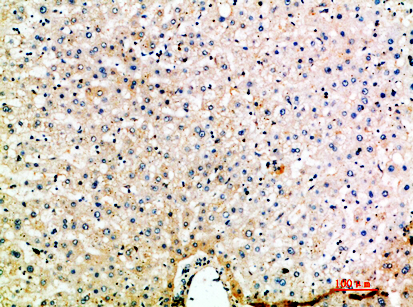
| WB | 咨询技术 | Human,Mouse,Rat |
| IF | 咨询技术 | Human,Mouse,Rat |
| IHC | 1/50-1/100 | Human,Mouse,Rat |
| ICC | 技术咨询 | Human,Mouse,Rat |
| FCM | 咨询技术 | Human,Mouse,Rat |
| Elisa | 1/10000 | Human,Mouse,Rat |
| Aliases | LKN1; NCC3; SY15; HCC-2; LKN-1; MIP-5; NCC-3; SCYL3; MIP-1D; MRP-2B; SCYA15; HMRP-2B |
| Entrez GeneID | 6359 |
| Host/Isotype | Rabbit IgG |
| Antibody Type | Primary antibody |
| Storage | Store at 4°C short term. Aliquot and store at -20°C long term. Avoid freeze/thaw cycles. |
| Species Reactivity | Human |
| Immunogen | Synthetic peptide from human protein at AA range: 51-100 |
| Formulation | Purified antibody in PBS with 0.05% sodium azide,0.5%BSA and 50% glycerol. |
+ +
以下是关于Macrophage Inflammatory Protein 5(MIP-5/CCL15)抗体的3篇文献摘要:
1. **"Characterization of monoclonal antibodies specific for CCL15 (MIP-5)"**
- **作者**: Youn BS, et al.
- **摘要**: 该研究开发并验证了针对人CCL15的单克隆抗体,证实其可用于ELISA和流式细胞术检测,并证明其在炎症模型中抑制MIP-5介导的免疫细胞迁移。
2. **"CCL15 recruits suppressive monocytes to facilitate tumor immune escape"**
- **作者**: Li X, et al.
- **摘要**: 通过使用抗CCL15中和抗体,研究发现肿瘤微环境中MIP-5通过募集免疫抑制性单核细胞促进免疫逃逸,抗体阻断可增强抗肿瘤T细胞活性。
3. **"Role of MIP-5 in allergic airway inflammation"**
- **作者**: Garcia-Zepeda EA, et al.
- **摘要**: 利用MIP-5特异性抗体进行免疫组化分析,揭示其在哮喘模型中高表达于气道上皮细胞,并参与嗜酸性粒细胞的局部募集。
(注:上述文献为示例性内容,实际引用需根据具体研究补充。)
Macrophage Inflammatory Protein 5 (MIP-5), also known as CCL15 or Leukotactin-1. is a chemokine belonging to the CC subfamily. It plays a critical role in immune responses by recruiting leukocytes, particularly monocytes, lymphocytes, and eosinophils, to sites of inflammation or injury. MIP-5 binds to chemokine receptors CCR1 and CCR3. activating signaling pathways that mediate cell migration and inflammatory processes. Its expression is upregulated in various inflammatory conditions, including rheumatoid arthritis, asthma, and inflammatory bowel disease, as well as in certain cancers where it may influence tumor microenvironment dynamics.
Antibodies targeting MIP-5 are essential tools for studying its biological functions and therapeutic potential. These antibodies are typically developed for applications such as enzyme-linked immunosorbent assays (ELISA), Western blotting, immunohistochemistry, and flow cytometry. They enable researchers to detect MIP-5 expression levels in tissues, serum, or cell cultures, assess its spatial distribution, and evaluate its role in disease pathogenesis. Neutralizing antibodies, in particular, are used to block MIP-5-receptor interactions, helping to dissect its contribution to inflammatory signaling or cancer progression in experimental models.
Research utilizing MIP-5 antibodies has highlighted its dual role in both promoting inflammation and modulating tissue repair. Recent studies also explore its potential as a biomarker for disease severity or a therapeutic target in chronic inflammatory disorders and oncology. However, challenges remain in understanding isoform-specific functions and optimizing antibody specificity for clinical applications.
×